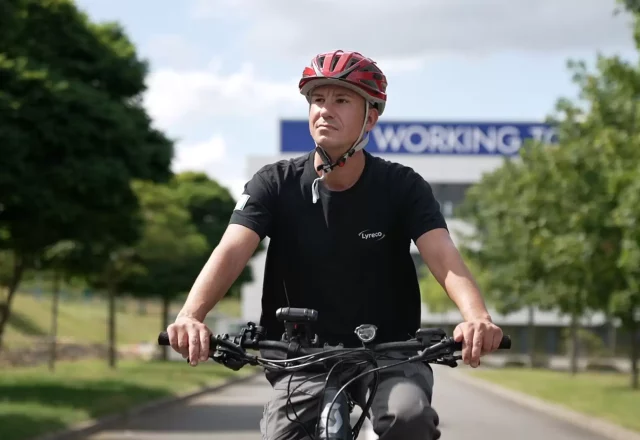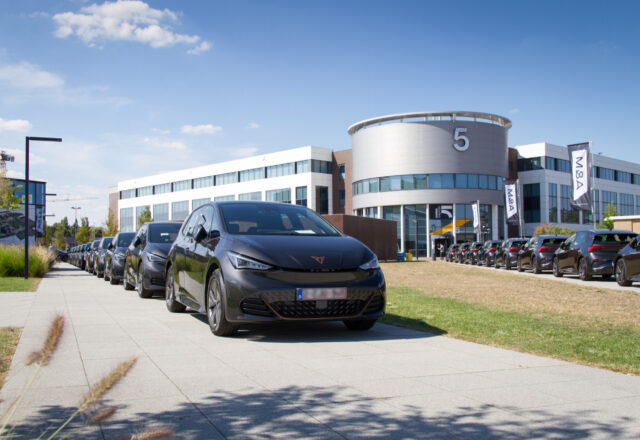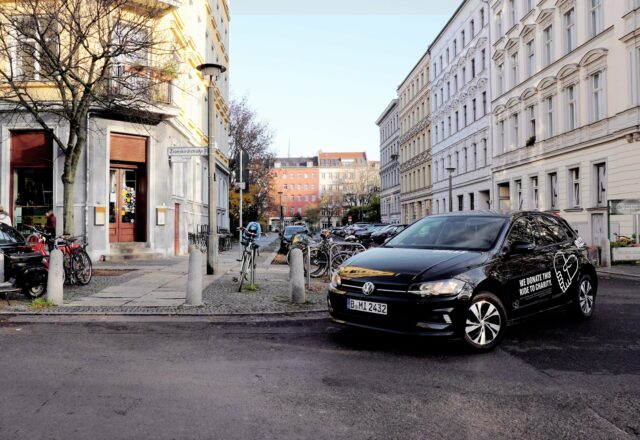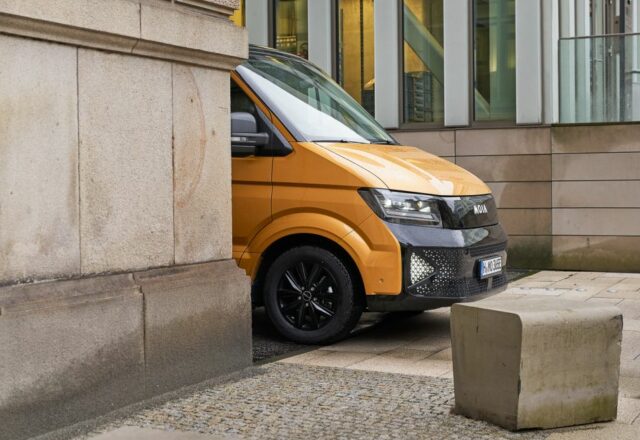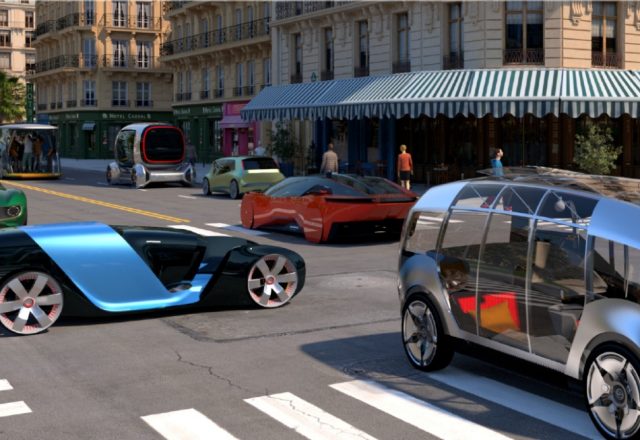
By 2030, Volkswagen plans to reduce the carbon footprint of its fleet in Europe by 40 percent. The all-electric car will certainly play a key role in this effort. Amid a maze of differing customer needs around the world, drive system preferences and business conditions, automakers cannot lose sight of renewable fuels – Professor Dr Thomas Garbe, the Head of Petrol and Diesel Fuels at Volkswagen AG, says in our interview.
Mr Garbe, companies and government authorities are increasingly searching for ways to lower fleet emissions – not least because of the Corporate Sustainability Reporting Directive (CSRD) and the Clean Vehicles Directive. Which concepts could fleet operators apply here?
They could certainly make the transition to an electric fleet, provided that they have the infrastructure for it. This is the silver bullet, so to speak – and I think that fleet operators in Germany, Scandinavia and the Benelux have already taken huge strides in this direction. But this transformation will take much, much more time in other regions. This is why Volkswagen is focusing on alternative drive technologies that can be used until the world market is totally electric.
Could you explain the reasons for your thinking in a little more detail?
You first have to look at current vehicle fleets: We have an enormously high number of petrol engines in use – around 1.4 billion road-going vehicles are currently in operation. All of them could become climate friendly if alternative fuels were used, ideally, even operated completely carbon neutrally.
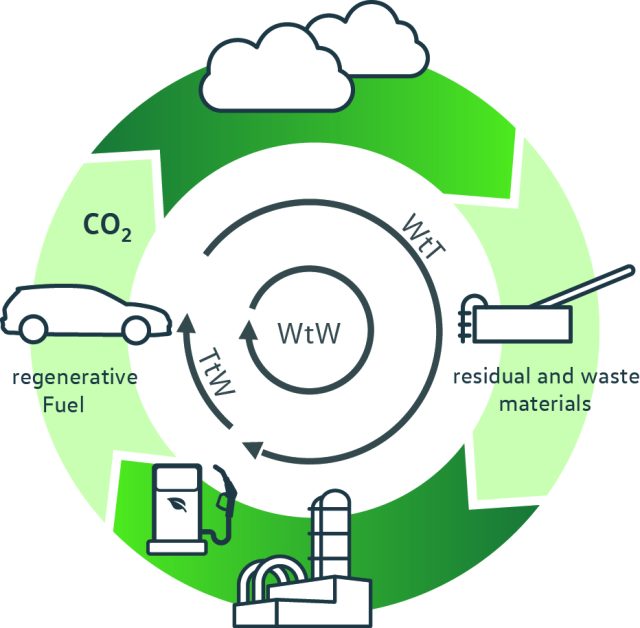
Already available today: Quantity limited to 20-30% of energy demand.
Which specific alternative fuels are you talking about?
In terms of diesel vehicles, the answer is pretty simple – you are talking about paraffinic fuels and paraffinic diesel. This is a broad range of sustainable raw materials, including fuels produced from organic residual material and waste. One good example is HVO, or hydrotreated vegetable oil. The oils are converted into hydrocarbons through a reaction with hydrogen. These substances have one special feature: You can mix any percentage of these hydrocarbons you want into diesel fuel, or you can use them completely by themselves as fuel. Vegetable oils like rapeseed oil can also be used to produce HVO. But the biggest environmental impact is produced when used cooking oil and residual materials from wood processing and paper production are applied. Many people may be unaware of one other thing as well: Biofuels like HVO are already in the marketplace. Their share of the European energy market for road vehicles could even climb to 20 percent to 30 percent by the end of the decade.
Can even higher amounts than the total you just cited be produced?
The amount of biofuels is naturally finite. Biofuels could be complemented by e-fuels – fuels produced from electricity and CO2. In terms of diesel engines, Fischer-Tropsch diesel is particularly interesting. The great thing about it is: It has the same physical-chemical qualities as HVO. As a result, all cars are automatically authorised to use it.

Which Volkswagen engines have been authorised for paraffinic fuels?
The official authorisation under the European standard EN 15940 has been in effect ex works since 2021 for all models equipped with the latest four-cylinder diesel engines (TDI) and since 2022 for the six-cylinder diesel. A “XTL” sticker on the petrol cap cover informs customers of this fact.
Which user groups would be interested in paraffinic fuels?
One example I can think of is companies that have mixed fleets consisting of electric vehicles and conventional petrol engines. Paraffinic fuels like HVO can be a very sensible complement. They facilitate carbon savings of about 70 percent to 95 percent in comparison with conventional diesel. They are sold simply as HVO or under various brand names like NesteMy and Eni HOVlution. The key aspect for users is that the fuel meets the requirements of the quality standard EN 15940 – petrol stations usually display a sign that bears this information.
It all sounds really good – is there any sort of downside to the fuels?
HVO is already sold by publicly accessible petrol stations in very many European countries. In Germany, HVO is allowed only for closed fleets at the moment. This means that individual customers must have their own HVO petrol station located on their own company premises. But once drivers leave Germany, they can easily fill up their vehicles with HVO in many other countries. For instance, paraffinic diesel is available nationally in the Netherlands, and the network is growing in Spain. We think that Germany will have created the regulatory framework for the public sale of HVO starting in April 2024. Until then, drivers can use fuel blends that are capable of substantially reducing CO₂ emissions.
“With the use of environmentally friendly fuels in authorised Volkswagen models, we enable customers throughout Europe to significantly lower their CO₂ emission.”
Prof. Dr. Thomas Garbe
Head of Petrol and Diesel Fuels, Volkswagen AG
What are fuel blends all about?
Diesel fuels that satisfy the requirements of the standard EN590 and are blended with paraffinic diesel are much more widely used than completely paraffinic diesel. These fuel blends include Diesel R33, Shell Blue Diesel, OMV EcoMotionDiesel, Aral Diesel Futura. All contain renewable fuel components, and the level of CO₂ emissions declines based on the particular mixing ratio. Use of these products can lower CO₂ emissions by at least 25 percent. Many of our fleet operators would be satisfied with such reductions if they were unable to switch to an all electric fleet – in particular because the 25 percent reduction in CO₂ would enable them to make progress in their sustainability matrix over the next three to four years. By the way, these fuels may be used in all diesel engines – including older vehicles that do not have the XTL sticker. But the sector’s future belongs completely to renewable biofuels and e-fuels like PtL (power to liquid).
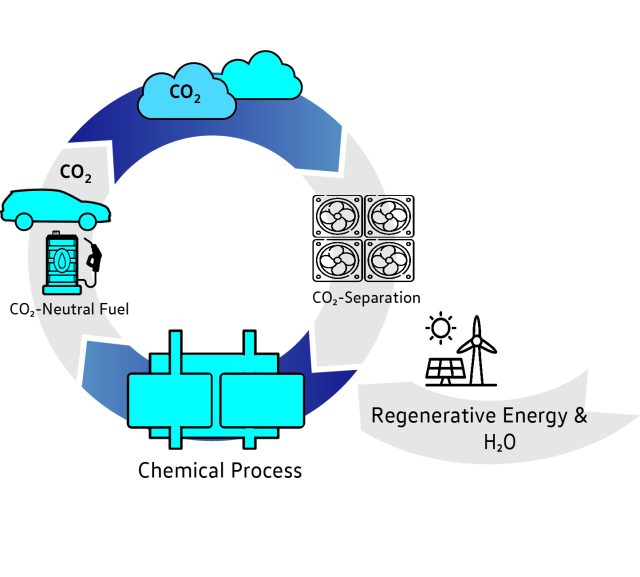
“Coming soon”: Unlimited quantity potential.
Could you tell our readers a little more about e-fuels?
E-fuels are a product of the future. Most likely, it will take until 2028 at the earliest before customers will have a real opportunity to fill up their vehicles with such fuels. We are currently in the ramp-up phase. E-fuels, something that is also called synthetic fuels, have a good opportunity to nearly replace conventional fossil fuels on a nearly one-to-one basis – and consumers should not have to make any large investments in the process. These fuels are produced with the help of CO₂ and electricity from regenerative sources. The end product is either synthetic diesel or synthetic petrol. E-fuels include X to liquid (XtL), GtL and PtL. First, you produce synthetic gas from various raw materials. You then apply the Fischer-Tropsch process to create diesel fuel (synthetic diesel) that fulfils the requirements of the standard EN 15940. This is the same standard that applies to HVO.
Let’s return to the topic of HVO for a moment. May these fuels be used in vehicles that do not have the XTL sticker on the petrol cap cover?
We have now made so much progress in terms of 100 percent approval of HVO or XTL that we can confer it for models going back to 2019. Customers simply have to stop by a Volkswagen service partner. The service partner will determine whether the vehicle can use HVO/XTL. If it is, approval and the sticker confirming it are granted. Our goal is to provide retrospective approval across Europe for models reaching back to 2015.
We have not said anything yet about petrol engines. What sort of options do fleet operators have here to reduce the CO₂ emissions of their fleets?
For petrol engines, we are already familiar with the fuel E10 (biofuel) that includes 10 percent ethanol. In Brazil, we have even gained experience with engines fuelled completely with ethanol. We are confident that we could approve our vehicles in Europe for E20, provided that we have the appropriate standard and fuel quality. We are currently testing E20 throughout all of our brands and platforms in a comprehensive process.
What about the development of E20 petrol stations?
The first E20 petrol station in Germany was opened recently in Mannheim. The ethanol being supplied there is primarily produced from waste materials like straw to get away from the conventional use of agricultural products. But, for legal reasons, this petrol station is not yet allowed to sell to the public, but only to fleet customers who are testing E20 as part of a closed fleet test with a total of 85 vehicles.
How have the general public and customer companies reacted to this test?
In southern Germany, customers have expressed a lot of interest in the work, particularly in the fleet area, and are reviewing suitable locations for other E20 petrol stations. The general public is also really excited about the project, even when they are told that this is hardly a cure-all.
What roadblocks does the highway leading to the wider use of E20 face?
We still have some work to do with E20, particularly in terms of standardisation and legal regulations. We are currently working with third parties on the development of a corresponding standard and hope that the Fuel Quality Directive can be appropriately amended on both the national and European levels. Our declared goal is to take the desires of industry and customers into consideration and officially authorise E20.
We have just one more item to cover: hydrogen! What challenges do you see in terms of Germany’s infrastructure for hydrogen stations?
We would need from 3,000 to 5,000 hydrogen stations for cars to meet national demand in Germany. In the transport sector, one possible option would be models in which such companies as logistics service providers could build their own hydrogen stations to supply their fleets. For long-distance transport on major traffic arteries, models have shown that you would need about 150 hydrogen stations to ensure 24/7 availability of the fuel.
Last question: As a developer, you use both biofuels and e-fuels. Do you notice anything when you are driving?
As a diesel driver, I have to say one thing: The new fuels are a shade better. During a cold start, conventional diesel will shake a bit more than HVO or Diesel R33. In contrast, the mileage of 100 percent HVO is only minimally higher.
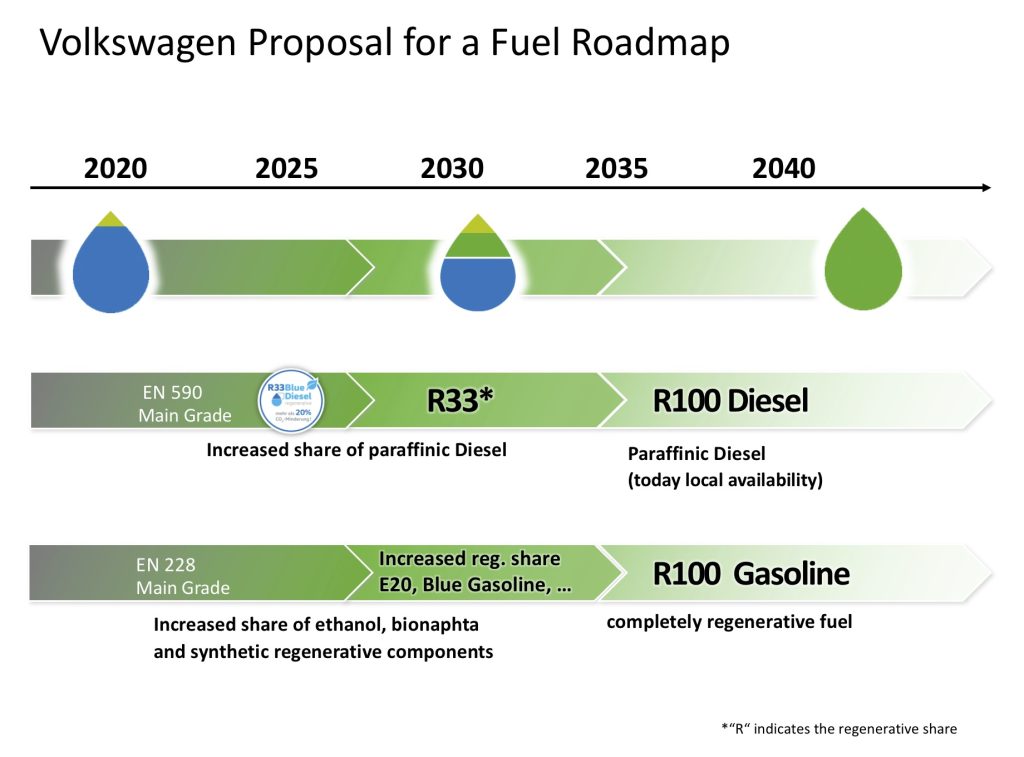
Status: 18.12.2023
© Volkswagen AG




